|
Michael
Madore, who has Asperger's Syndrome (a form of autism),
started to draw maps and diagrams as a child in order to
corroborate increasingly specialized interests that began with
geography and culminated by the age of twelve with an obsession
with office market vacancy rates.
As a teen he took refuge in cartoons, radio
playlists, mechanical drawing, and weather statistics. In college
he majored in art history, focusing on medieval manuscript
illumination and nineteenth century artists/illustrators such as
William Dadd, Victor Hugo, and Grandville.
After graduating in 1977, Madore moved to New
York where he first began to consciously make "art" while
remaining on the periphery of the emerging East Village art scene.
He moved to New Haven in 1983 and for nearly a decade he continued
to work in relative isolation, teaching himself to paint while
meticulously creating and cataloging a world populated by the
likes of King Charles (who had the ability to render himself
invisible or to take on animal forms), the Sirenians (a quasi
scientific/monastic tribe of nervous, absentminded "researchers
and sensors"), and innumerable forest, aquatic, and space
entities. In 1987, while hospitalized at Yale-New Haven Hospital,
he took the advice of his psychiatrist and entered the Yale MFA
painting program. After graduating in 1990, Madore moved back to
New York where he has continued painting and drawing while working
as a medical editor, proofreader, and writer on topics ranging
from synesthesia, tics, and ikebana.
|
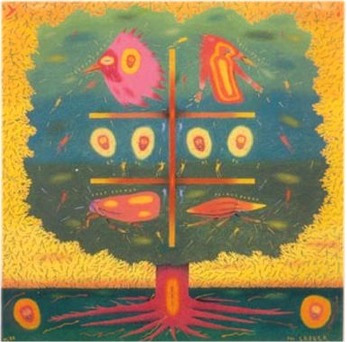 |
|
"The
Ladder" (oil on canvas 42" x 42") |
I have an autistic disorder,
and I tend to be very literal. So when my psychiatrist at Yale-New
Haven Hospital suggested I apply to the Yale University School of
Art, my response was “Okay.” I thought he was talking about a day
treatment program!
I have to admit, when I got accepted I
didn't really think it was a big deal until I saw how seriously
the other students were taking the whole thing. I mainly saw it as
an opportunity to do research in cartography, which is a subject
I've been strongly interested in since I was a kid. Cartography
and drawing were my way of coping. By 6, I had memorized all of
the islands off the coast of British Columbia, and by the time I
was 11 or 12, I was “designing” shopping centers, figuring out the
best arrangement of all the retail components. Then when I was a
teenager, and even now as an adult, I became obsessed with
commercial leasing activity. I have to know office vacancy rates.
And not merely in New York City where I live, but nationwide. To
this day, I also remain obsessed with blueprints and any kind of
technical drawing, since they neutralize the threat posed by full
dimensionality. I got a full scholarship to go to Trinity College
[in Hartford, Conn.], where I started off majoring in
architecture, and ended up in art history, and then in English
because I had some time to kill and thought psychoanalytical
literary theory would magically explain social behavior. I had
always been very anxious about hidden agendas and reading between
the lines. I graduated with a dual degree in art history and
English. I was going to go and get my master's in English, but I
knew, without knowing the name of it, that I was incapable of
this. I couldn't write more extended and logically consistent
academic types of papers, so I had to abandon a university career.
I didn't even know how to shake hands until after college.
|
 |
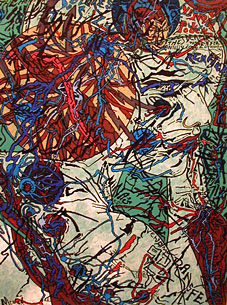 |
|
"Eye
raffle" (ink & acrilyc on paper, 25 x 10", 2000) |
"Dolores" (mixed media on paper, 19x25", 2001) |
Cartography and drawing
are my way of coping with Asperger's Syndrome. As a kid, I was
diagnosed with everything else but that. My AS is comorbid with
Tourette's and ADHD. I use art to try to figure out how to
communicate in ways that other people seem to take for granted.
One of my recent drawings, “Eye Raffle,” was done specifically to
help me clarify the problem of the logistics of eye contact. This
was very hard to do, because I've always felt eye contact is so
arbitrary—when you look at someone and how long you look at
someone and how you return a gaze. It seems like a raffle.
|
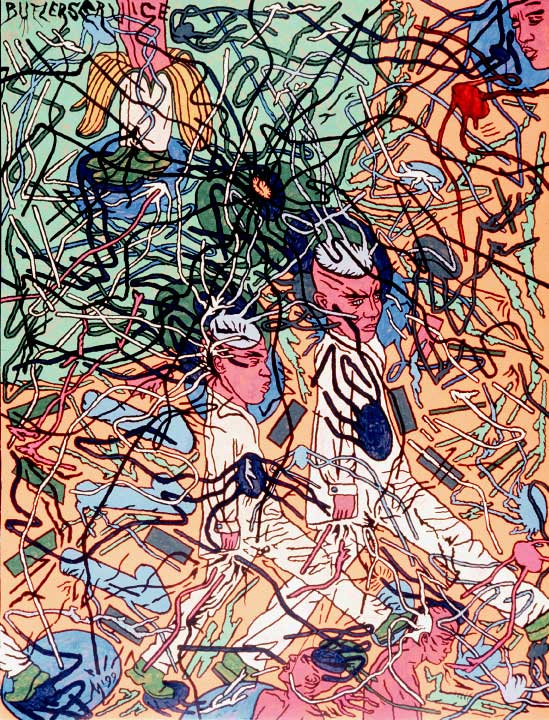 |
The pieces that were on display
at the American Visionary Art Museum in Baltimore were newer and
reflected my obsession with opiates. Mercifully, I was not a good
addict. All I take now is Adderall. I used to take anxiolytics,
but my doctors stopped that because of the potential for working
me back into opiates. When it comes to medication, I usually have
the opposite reaction to what's expected. Pot was like an
amphetamine. Cocaine makes me sleepy. Some anxiolytics would
actually make me “hyper.” I used heroin because it would shut down
the sensory overload. Anxiety is still my biggest issue. I spend a
lot of time trying to tone down a lot of conflicting sensory
information. I am acutely aware of noise.
I am perpetually trying to figure
out, “Am I hearing something? Am I overhearing the sounds of
my cats? Am I over interpreting?” Heroin quieted this internal
interrogation, and it helped me retain a certain
functionality. For me, Adderall works as an antidepressant in
addition to calming and focusing me in terms of executive
function. Drawing forces me to coordinate my senses, and it
helps me cope with my illness. It allows me to “remap” myself,
in a sense. |
|
"
Butler service" (ink on paper, 25 x 19", 1999) |
I've always been obsessed
with diagrams. I have a problem with volume and dimensionality,
the sense of moving through space, which manifests itself in a
kind of motor clumsiness and an obsession with symmetry. I
constantly feel compelled to center or “arrange” myself in
whatever space I'm in. To help overcome this I joined a gym, which
helped. I started going to dance performances, but then I started
becoming obsessed with the history of dance. I even considered
becoming a dance critic, but I knew there was no way I could
verbalize physical movement except in a disjointed, rambling
manner. Plus, I'd never match faces with names, and [would]
thereby incur the wrath of equally high-strung, creative types. I
was just part of a big autism study, and for part of it they test
reflexes, and [the researchers] would say “pull,” and I didn't
know how to translate that into the proper body movement. I kept
doing the opposite, and [the researcher] kept getting really
frustrated. I was trying, but I didn't understand how you'd pull
your leg out. It's the same with choreography. I don't understand
how a person can translate a verbal command into physical action.
Autism is like continually mistranslating or getting stuck on a
missing link or conjunction.
|
|
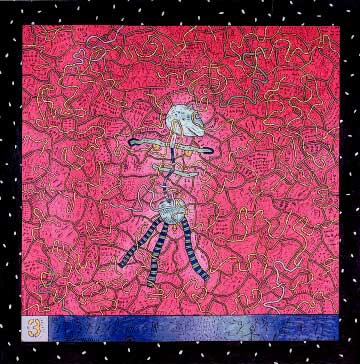 |
|
"Trapped"
(enamel/magic marker on paper, 1979) |
Curiously, the one group
who has been the least supportive of my diagnosis is my artist
friends. I think they feel the most threatened. And I agree to
some extent, because it seems that the very concept of creativity
is becoming medicalized. I agree with Lawrence Osborne and his
book, “American Normal: The Hidden World of Asperger Syndrome.” He
worries that we are medicalizing creativity to the point where it
becomes a diagnostic cluster of symptoms. Years ago, it was
theorized that perhaps the creative process itself is linked to a
kind of bipolar disorder. And I think when people now hear autism,
it really freaks them out, because now Virginia Woolf has turned
into Rain Man—and I'm assuming it's not a pretty picture.
I don't see my condition
as a stigma at all. Ever since I was little, I was used to being
way out on the periphery in order to attain safe and critical
distance. I was very good with language, so I was able to bluff
myself out of many potentially bad situations by sweet-talking
potential adversaries into oblivion. By the time I got to college,
it was okay to be in your own world; everyone was specializing in
the '70s. I don't really feel threatened or compromised by people
pathologizing me, or turning me into a case study, or trying to
force a causality, or a 1:1 correspondence between my work and my
autism.
|
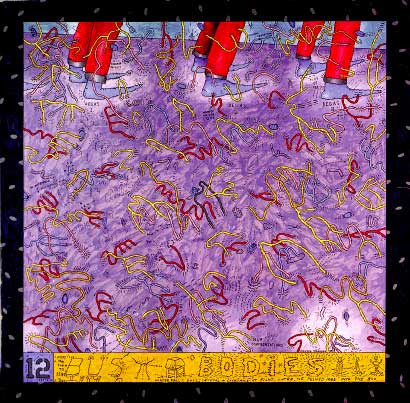 |
|
"Busy
bodies" (enamel/ magic marker on paper, 1979) |
|











